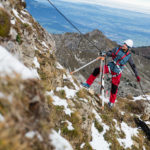Namibia is almost twice the size of Germany but has only around 2.5 million inhabitants, less than the state of Schleswig-Holstein. The country offers expansive velds and nature like from a world of fantasy, along with the oldest desert and the largest underwater lake on earth. Namibia even protects its natural wonders in its constitution, the first country in the world to do so. You can find out more about this nation in south-western Africa in our country profile.

A long-lived plant
In favorable conditions, the living fossil Welwitschia mirabilis, which grows in the Namib desert, can live for up to 2,000 years.

Enormous underground lake
The Otavi Mountains are home to Dragon’s Breath: a cave named for the moist air rising from its entrance. It contains the largest underwater lake in the world more than 65 meters below the earth’s surface, which was first discovered in 1986. Its total depth is estimated at up to 200 meters.

Plenty of room for nature
44 percent of Namibia’s land is protected or used for sustainable practices.

Named after a desert
The Namib desert is approximately 80 million years old, making it the oldest desert in the world. It measures roughly 95,000 km2 and covers the entire coastline. Since Namibia’s independence from South Africa in 1990, it is also the country’s namesake.

Largest meteorite on record
The Hoba meteorite is the largest meteorite discovered on earth to date. It is located on the grounds of the “Hoba” farm in the Otavi Mountains. The iron meteorite weighs around 60 tons and fell to earth about 80,000 years ago.

German beer
The country was shaped by German colonialism starting in 1884 and decades of being a South African colony starting in 1920. In Namibia’s capital Windhuk, for example, beer is brewed in compliance with Germany’s purity order and enjoys immense popularity in the entire country.

Communicative driving
Democratic road traffic: In Namibia, there are intersections with four stop signs, called 4-way stops. Whoever arrives at the intersection first has right of way. The drivers decide amongst themselves who that is.

Skiing on sand dunes
One of the tallest dunes in the world can be found in the Namib desert. In Sossusvlei, the “Big Daddy” dune protrudes 380 meters into the sky. You can even snowboard and ski on the sand dunes of the Namib.

Sun-drenched
300 days and more than 3,000 hours of sunshine per year – Namibia is sun-drenched even by African standards and uses this to generate solar power. The renewable energy helps create green hydrogen on a large scale, making the country a potentially important energy producer on the global market.

Sparsely populated
Namibia has a scarce three inhabitants per square kilometer. Only Greenland and Mongolia are more sparsely populated.

Cheetah heaven
The country is home to up to 3,500 free-roaming cheetahs: the largest population of these feline predators in the world.










